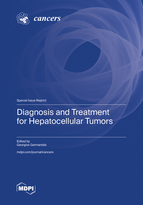Diagnosis and Treatment for Hepatocellular Tumors
A special issue of Cancers (ISSN 2072-6694).
Deadline for manuscript submissions: closed (30 June 2023) | Viewed by 51595
Special Issue Editor
Interests: NASH; HCC; liver biology; liver immunology; HBV; HCV; clinical liver diseases
Special Issues, Collections and Topics in MDPI journals
Special Issue Information
Dear Colleagues,
Hepatocellular carcinoma (HCC) is the most prevalent primary liver cancer, accounting for >80% of primary liver cancers worldwide, with geographical variations among its prevalence. It is the leading cause of death in patients with cirrhosis, with an annual HCC incidence of 1–6%. The diagnosis of HCC, relying solely on noninvasive criteria, is currently under debate due to the need for molecular information that necessitates tissue biopsies, while therapy is provided in accordance with tumor stages and the anticipated advantages of major interventions, following the Barcelona Clinic Liver Cancer (BCLC) staging system. Principally, resection, transplantation and local ablation are most commonly performed in patients with early-stage HCC tumors, while TACE and systemic therapy are respectively the preferred treatment options for intermediate- and advanced-stage tumors. However, the HCC tumor immune microenvironment (TME) affects response to current anti-PD-1/PD-L1 immunotherapies. Therefore, an enhanced understanding of the immunobiology of TME is essential for the development of predictive biomarkers of patient stratification and strategies of drug combinations to improve therapeutic efficacy, especially for patients with tumors irresponsive to anti-PD-1/PD-L1 therapy. Taking into account the health burden of HCC worldwide, with this Special Issue we aim to enhance our knowledge of innovative diagnostic and prognostic methods, and to discuss experimentation with different novel treatment modalities, believed to be of utmost priority to progress in our seemingly never-ending fight against hepatocellular cancer.
Dr. Georgios Germanidis
Guest Editor
Manuscript Submission Information
Manuscripts should be submitted online at www.mdpi.com by registering and logging in to this website. Once you are registered, click here to go to the submission form. Manuscripts can be submitted until the deadline. All submissions that pass pre-check are peer-reviewed. Accepted papers will be published continuously in the journal (as soon as accepted) and will be listed together on the special issue website. Research articles, review articles as well as short communications are invited. For planned papers, a title and short abstract (about 100 words) can be sent to the Editorial Office for announcement on this website.
Submitted manuscripts should not have been published previously, nor be under consideration for publication elsewhere (except conference proceedings papers). All manuscripts are thoroughly refereed through a single-blind peer-review process. A guide for authors and other relevant information for submission of manuscripts is available on the Instructions for Authors page. Cancers is an international peer-reviewed open access semimonthly journal published by MDPI.
Please visit the Instructions for Authors page before submitting a manuscript. The Article Processing Charge (APC) for publication in this open access journal is 2900 CHF (Swiss Francs). Submitted papers should be well formatted and use good English. Authors may use MDPI's English editing service prior to publication or during author revisions.
Keywords
- HCC
- hepatocellular tumors
- diagnosis
- treatment
- BCLC-B
- BCLC-C
- anti-PD-1/PD-L1 immunotherapy
- TKIs
- combinations
- TME
- addiction loops
- interventions
- established data
- future perspectives







